Last Updated on October 6, 2024 by Kittredge Cherry

Saints Sergius and Bacchus were third-century Roman soldiers, Christian martyrs and men who loved each other. Their story is told here in words and images for their feast day on Oct. 7.
They are by far the best documented, most widely worshiped and most influential male paired saints in Christian history. They are some of the earliest Christian martyrs. The close bond between Sergius and Bacchus has been emphasized since the earliest accounts, and recent scholarship has revealed their homosexuality. The oldest record of their martyrdom describes them as erastai (Greek for “lovers”). Scholars believe that they may have been united in the rite of adelphopoiesis (brother-making), a kind of early Christian same-sex marriage. Their names were often included in these rites of same-sex union, along with other saintly male pairs. Some see them as patron saints of same-sex couples. But their devotion to each other has inspired people of every sexual orientation over the centuries.
From ancient times until today these “gay saints” have inspired some of the most beautiful art depicting the holiness of same-sex couples, sometimes in a homoerotic way. A classic example of paired saints, Sergius and Bacchus were high-ranking young officers in the Roman army. Sergius was primicerius (commander) and Bacchus was secundarius (subaltern officer). They were tortured to death around 303 in present-day Syria after they refused to attend sacrifices to Zeus, thus revealing their secret Christianity.

Saints Sergius and Bacchus. 7th Century icon from St. Catherine’s Monastery on Mt. Sinai in Israel. (Wikimedia Commons) Available on greeting cards and other products at Zazzle.
Yale history professor John Boswell names Sergius and Bacchus as one of the three primary pairs of same-sex lovers in the early church in his 1995 book “Same Sex Unions in Pre-Modern Europe”. (The others are Polyeuct and Nearchus and Felicity and Perpetua.) Paired military saints were popular in the Middle Ages. Sergius and Bacchus were the most famous and one of the earliest couples, but others include Maurice and Theofredus of the Theban legion. An appendix in the book includes Boswell’s translation of “The Passion of SS. Serge and Bacchus” from the original Greek text dated 373-395. It was the first time that an ancient hagiography of Sergius and Bacchus was ever translated into English.
Today LGBTQ Christians in the west can get status from their religion but may hide their sexual orientation to avoid condemnation. However Sergius and Bacchus faced the opposite dilemma. In the Roman army homosexuality was accepted and perhaps even encouraged, but Christianity was taboo.
New in 2024: Three new images of Sergius and Bacchus
Three new artworks of Sergius and Bacchus are added to their profile here for their feast day in 2024.
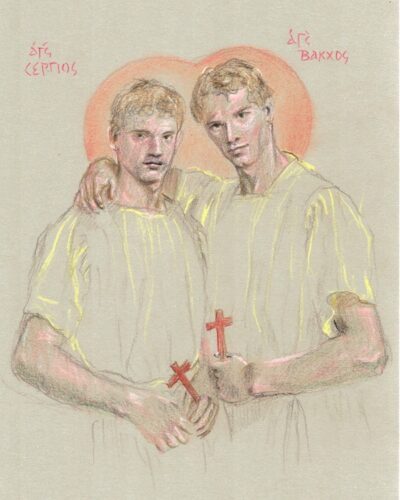
“Sergius and Bacchus” by Tobias Haller
Sergius and Bacchus were sketched by iconographer Tobias Haller in an intimate pose that affirms gay sexuality. Meanwhile the crosses in their hands proclaim their Christian faith. Haller is also an author, composer, and retired vicar of Saint James Episcopal Church in the Bronx, still assisting at a parish in Baltimore, Maryland. He enjoys expanding the diversity of icons available by creating icons of LGBTQ people and other progressive holy figures as well as traditional saints. His artwork appears frequently on Q Spirit.
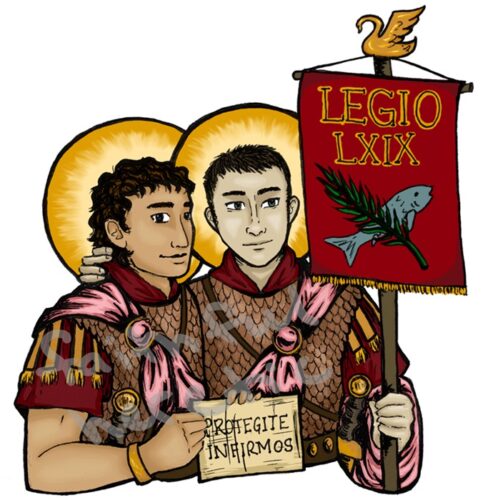
“Saints Sergius and Bacchus” by Faithful Heretic
Sergius and Bacchus are interpreted as protectors of the queer community in an icon loaded with symbolism by the artist known as Faithful Heretic. The saints wear lavender cloaks to indicate that they are a gay couple. Many Roman banners had an eagle on top, but theirs has a swan, a species known to form stable male-male pairs. Viewers may be able to decode the gay sex joke in the Roman numerals.
Their other sign declares, “Protegite infirmos” (Latin for “protect the weak.”) “It’s artistic license, but I imagine them going to their martyrdom in defense of their community, or in defense of the ‘least of these,’” Faithful Heretic told Q Spirit. Raised Mormon, Faithful Heretic is an Episcopalian lay minister and a lifelong student of history, especially medieval history and LGBTQ history.
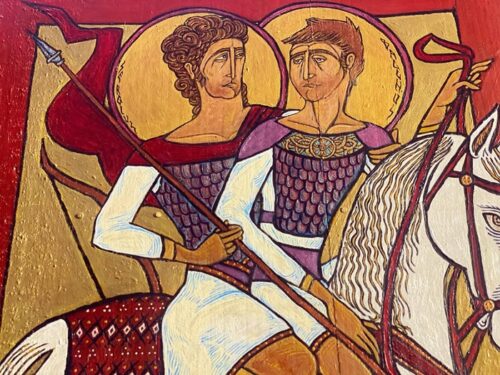
“Sergius and Bacchus” by Justin Craig Morgan
Traditional icons sometimes show Sergius and Bacchus on horseback, each riding his own horse. But Chicago artist Justin Craig Morgan emphasizes their close connection as a same-sex couple by putting them astride the same horse in a 2024 icon.
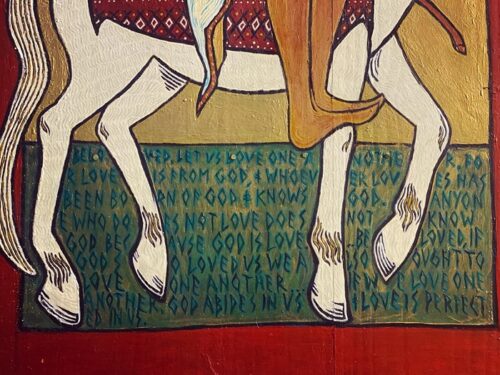
Detail from “Sergius and Bacchus” by Justin Craig Morgan
With overlapping pink-rimmed halos, they stand upon ground that is inscribed with scripture — not an anti-gay “clobber passage,” but a “love passage” from 1 John 4. It begins, “Beloved, let us love one another, for love is from God, and whoever loves has been born of God and knows God.” The artist calls it “a reminder that the Biblical and theological starting point for gay Christians is the Love Ethic of Jesus first and foremost, from which the prohibitive ‘clobber’ passages are subsequently interpreted.”
Sergius and Bacchus were punished for being Christian
Sergius and Bacchus were both young nobles in the court of Emperor Maximian. Their conversion to Christianity was discovered when they tried to avoid accompanying the emperor into a pagan temple with the other guards. They probably spoke their local language and Latin, the official language of the Roman military.
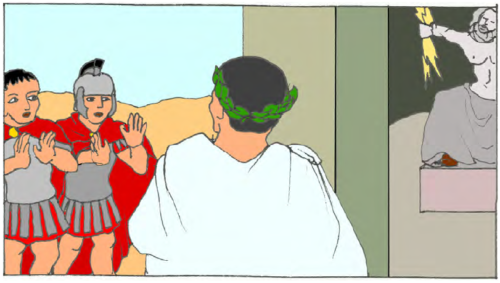
Sergius and Bacchus refuse to go into the temple of Zeus with the emperor in an image from the book “Heavenly Homos, Etc.: Queer Icons from LGBTQ Life, Religion, and History” by Jan Haen. He draws scenes that are rarely if ever portrayed by artists.
When their Christian faith became known, Sergius and Bacchus were arrested and paraded through the streets in women’s clothing in an unsuccessful effort to humiliate them. This punishment apparently confirms that they defied sex roles by being lovers. Early accounts say that they responded by chanting that they were dressed as brides of Christ. In Boswell’s translation, they proclaim:
“We rejoice in you, Lord, because you have clothed us with the garment of salvation, and have covered us with the robe of righteousness; as brides you have decked us with women’s gowns and joined us together for you [or: “joined us to you”] through our confession.”
“Sergius + Bacchus, or, the Saints of Drag” by Matthew of Queer Catholic Icons
They told their captors that women’s dress never stopped women from worshiping Christ, so it wouldn’t stop them, either. A rare depiction of the pair in women’s clothing is presented in “Sergius + Bacchus, or, the Saints of Drag” by Matthew, a practicing Roman Catholic who shares his artwork at Queer Catholic Icons on Instagram as @queer.catholic.icons. Their halos merge as they hold hands and lean on each other until their foreheads touch, smiling with the kind of love and inner peace that no humiliation can stop.
Then Sergius and Bacchus were separated and beaten so severely that Bacchus died.
Sergius and Bacchus: Bonded together forever
According to Boswell’s translation, Sergius wept that night in prison, heartsick over the death of Bacchus. Quoting a psalm of Biblical king David, he wailed with grief that may echo David’s lament over Jonathan. Sergius cried out:
“No longer, brother and fellow soldier, will we chant together, ‘Behold, how good and how pleasant it is for brethren to dwell together in unity!’ You have been unyoked from me and gone up to heaven, leaving me alone on earth, bereft [literally, ‘made single’], without comfort.”
That night Bacchus appeared to Sergius “with a face as radiant as an angel’s, wearing an officer’s uniform.” He urged Sergius not to give up because they would be reunited in heaven as lovers and be bound together forever. His statement is unique in the history of martyrs. Usually the promised reward is union with God, not with a lover, but not with Sergius and Bacchus. Bacchus urges Sergius in Boswell’s translation:
“Why do you grieve and mourn, brother? If I have been taken from you in body, I am still with you in the bond of union…. Hurry then, yourself, brother, through beautiful and perfect confession to pursue and obtain me, when finishing the course. For the crown of justice for me is with you.”
Crowning was a part of heterosexual wedding ceremonies at that time. Over the next days Sergius was tortured and eventually beheaded.
A Coptic church hagiography states that the body of Bacchus was tossed into the Euphrates River and discovered by a pair of holy men. They are described as brothers, but that is sometimes a code for a gay couple:
“The Lord protected the body and the waves brought it to the shore near two ascetic holy men who were brothers. The angel of the Lord appeared to them and commanded them to go and carry away the body of the Saint. When they came to where the body was, they found an eagle and a lion protecting it. The beasts spent a whole day and a night guarding it without harming it, although they were beasts of prey, for they had been commanded by divine providence to protect the body. The two holy men took the body with great honor, singing hymns until they came to their cave where they buried it.”
Sergius’ tomb became a famous shrine, and for nearly 1,000 years the couple was revered as the official patrons of the Byzantine army. Many early churches were named after Sergius, sometimes with Bacchus. They have been recognized as martyrs by the Catholic, Eastern Orthodox and Oriental Orthodox churches. The pair was venerated through the Mediterranean region, the Middle East, Latin America and among the Slavs.
The Roman Catholic Church stripped Sergius and Bacchus from its liturgical calendar in 1969 — the same year that New York’s Stonewall riots launched the modern gay liberation movement. Supposedly they were downgraded due to a supposed lack of historical evidence, but some see it as an anti-gay action since they clearly had many churches dedicated to them since the sixth century and their earliest hagiography dates back to the mid-fourth century. Sergius and Bacchus continue to be popular saints with Christian Arabs and now among LGBTQ Christians and allies.
Sergius and Bacchus icon secretly rescued from Ukraine
A famous 7th-century icon of Sergius and Bacchus was secretly rescued from the war in Ukraine and taken to the Louvre in Paris. It is on display through Nov. 6, 2023 in the “Origins of the Sacred Image” exhibit.
Previously the icon was housed at the Khanenko National Art Museum in Kyiv. A missile attack damaged the museum building during the Russian invasion in October 2022.
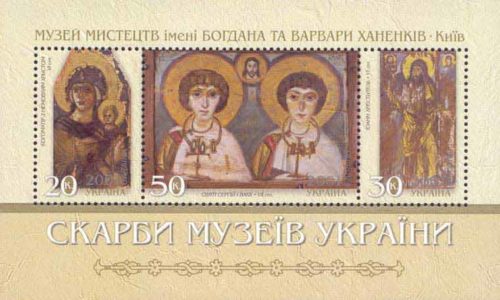
An icon of Sergius and Bacchus from a Kyiv museum appears on a Ukrainian postage stamp. (Wikimedia Commons)
The staffs of both museums worked together “in utmost secrecy” to transfer the Sergius and Bacchus icon and 15 other emblematic works from Ukrainian national collections to France, according to a Louvre news release.
The icon appears on a Ukrainian postage stamp and on the cover of “Same Sex Unions in Pre-Modern Europe” by John Boswell.
Sergius and Bacchus were soldier-saints, and some are praying for them to bring peace and protect the people and culture of Ukraine.
Sergius and Bacchus are celebrated in contemporary art
In the powerful 2013 painting at the top of this post, Alessio Ciani of Italy shows young Sergius and Bacchus embracing in their red-and-white military uniforms. He has done a wide variety of LGBTQ illustrations and gay homoerotic art. His work has been exhibited in Milan and Perugia.

“Saints Sergius and Bacchus” by Andrew Freshour
Sergius and Bacchus kiss each other in a watercolor painting that sparked both controversy and praise when Andrew Freshour introduced it in 2023.. They have different skin tones, but the same kind of halo. The chain binding them together adds just the right note of somber grace.
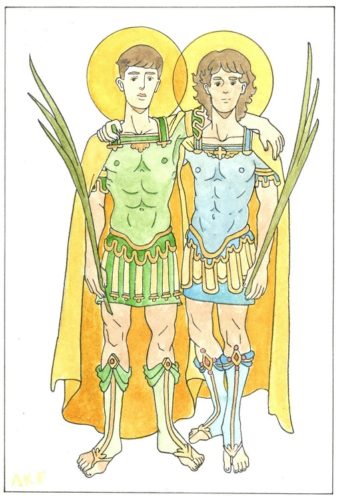
Sergius and Bacchus by Andrew Freshour
Freshour is a New Hampshire artist and gay Episcopalian who earned a BFA in illustration from the New Hampshire Institute of Art in 2013. Sergius and Bacchus appear with refreshing lightness and clarity in an another Freshour painting of them.
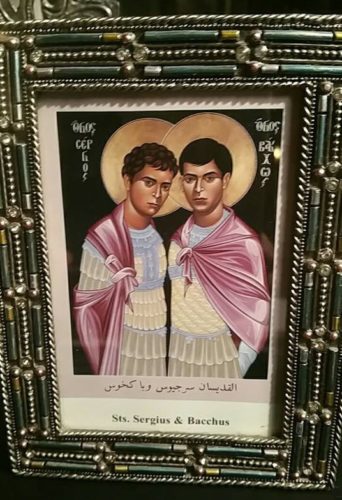
“Saints Sergius and Bacchus” by Robert Lentz is part of Scott Sella’s sacred art collection in Akron, Ohio. Photo by Scott Sella.
“Saints Sergius and Bacchus” by Robert Lentz is probably the best-known icon of the pair in the LGBTQ community. It was painted by Brother Robert Lentz, a Franciscan friar and world-class iconographer known for his innovative icons. They wear matching armor and lavender cloaks and their haloes overlap. The icon of the loving pair was commissioned by the Living Circle, an interfaith LGBTQ spirituality center founded by Dennis O’Neill. It was first displayed in June 1994 when they carried it in Chicago’s Gay Pride Parade for the first time. Prints of “Saints Sergius and Bacchus” are available through the “Ecumenical Icons” collection of Lentz icons at Trinity Stores.
“Saints Sergius and Bacchus” is one of 10 Lentz icons that sparked major controversy since 2005. Critics accused Lentz of glorifying sin and creating propaganda for a progressive sociopolitical agenda. They caused such a stir that in order to keep the peace between his Franciscan province and the Archbishop of Santa Fe, New Mexico, Lentz temporarily gave away the copyright for the 10 controversial images to his distributor, Trinity Stores. Lentz’ own moving spiritual journey and some of his icons are included in the book Art That Dares: Gay Jesus, Woman Christ, and More by Kittredge Cherry.
“Saint Sergius and Saint Bacchus” from Cristianas y Cristianos de Madrid LGTB+H (CRISMHOM)
An icon of Sergius and Bacchus was painted by a member of the Cristianas y Cristianos de Madrid LGTB+H (CRISMHOM), an LGBTQ Christian community in Madrid, Spain. The artist is serving as a missionary in Mozambique. He portrays Christ inside a rainbow medallion uniting Sergius and Bacchus as they join hands and gaze into each other’s eyes. Sacred flames burn in their hearts.
Sergius and Bacchus appear on a stained glass window donated in 2011 to an Illinois church by its LGBTQ parishioners. The Sergius and Bacchus window was dedicated in September 2011 at St. Martha’s Church in Morton Grove, Illinois, as a gift from its LGBTQ members. Dennis O’Neill, pastor, believes it is the first window dedicated to Sergius and Bacchus in any church in the United States. O’Neill is the author of Passionate Holiness: Marginalized Christian Devotions for Distinctive People. The book includes a chapter retelling the love story of Sergius and Bacchus with historical detail.
The Sergius and Bacchus window is part of a project in which members of St. Martha’s diverse congregation were selecting and paying for a set of 20 windows of saints from their various homelands. LGBTQ members contributed the “friendship window” depicting Sergius and Bacchus. It is a companion to the “marriage window” which shows St. Elizabeth of Hungary and her husband, Blessed Ludwig of Thuringia.
Artist Plamen Petrov worked with Daprato Rigali Studios to design and create the stained glass windows. He was born in Sevlievo, Bulgaria in 1966 and currently lives in Chicago. He graduated from University St. Cyril and St Methodius University of Veliko Tarnovo, Bulgaria’s Faculty of Fine Art in 1995, with an M.F.A. in graphic art – printmaking and pedagogy of figurative arts. For more than a dozen years he specialized mostly in stained glass, but his creativity takes many forms, since he also works in mosaics, murals, oil, acrylic, photography and graphic design. His artwork may be seen across Chicago and Illinois, and in many countries all over the world.
Massachusetts artist Brandon Buehring included Sergius and Bacchus in his “Legendary Love: A Queer History Project.” He uses pencil sketches and essays “to remind queer people and our allies of our sacred birthright as healers, educators, truth-tellers, spiritual leaders, warriors and artists.” The project features 20 sketches of queer historical and mythological figures from many cultures around the world. He has a M.Ed. degree in counseling with an LGBT emphasis from North Carolina State University in Raleigh. He works in higher education administration as well as being a freelance illustrator based in Northampton, Massachusetts.
The painting below is by California gay artist Rick Herold. “I over the years as a painter have been interested in the idea of the spirit and the flesh as one — began by Tantric art influences and then using my Catholic background,” he told the Jesus in Love Blog. He paints with enamel on the reverse side of clear plexiglas.
Herold has a bachelor of arts degree in art and theology from the Benedictine Monastic University of St. John in Minnesota and a master of fine arts degree from Otis Institute of Art in Los Angeles. His religious artwork included a Stations of the Cross commissioned by Bob Hope for a church in Ohio before a conflict over modern art with the Los Angeles cardinal led to disillusionment with the church. Herold came out as gay and turned to painting male nudes.
A banner saying “patrons of same sex couples” hangs above Bacchus and Sergius in a colorful icon by Maria Cristina, an artist based in Las Cruces, New Mexico.
On the day that California artist Ray Avito first heard the story of Sergius and Bacchus, he sketched a delightfully unpretentious portrait of the pair (pictured above). He said it was based on “the suspicion that they may have been more than just comrades in arms.”
Sergius and Bacchus are among the many saints painted by Georgia artist Tony de Carlo. Raised Catholic, he started painting saints to counteract the church’s demonization of LGBTQ people. For more info, see my article Tony De Carlo: Artist affirms gay love with saints, Adam and Steve, and marriage equality paintings.
Historical men who loved men, including Sergius and Bacchus, are painted by American artist Ryan Grant Long in his “Fairy Tales” series. Sergius and Bacchus are usually portrayed as static icons, side by side staring straight at the viewer. But Long catches them gazing into each other’s eyes during a private moment in their prison cell. For more info, see my article Artist paints history’s gay couples: Interview with Ryan Grant Long.
Noted British photographer Anthony Gayton does stylized homoerotic photos based on the history of gay culture. He shows Sergius and Bacchus stripped and bound as prisoners in two separate photos. The images are intended to be shown together, but by design they can also be separated.
Appropriate Bible quotes are on banners above them. For Bacchus: “But I will not take my love from him, nor will I ever betray my faithfulness.” (Psalm 89:33). For Sergius: “All thy commandments are faithful, they persecute me wrongly; help thou me.” (Psalm 119: 86)
His Sergius and Bacchus photos belong to the series “Five Saints.” In addition to exploring saints, Gayton’s work uses historical themes inspired by such diverse sources as mythology, Renaissance and Baroque painting and early photography. Gayton’s work is published in his book Sinners and Saints.

“New icon: Saints Sergius and Bacchus” by Kalle Hamm
Finnish artist Kalle Hamm created an image of Sergius and Bacchus that is suitable for society now, when “icon” is more likely to mean a computer symbol than a religious figure. He writes their story using emoji with the goal of affirming LGBTQ people in a contemporary, accessible way. Hamm’s 2018 “New Icons” series includes Sergius and Bacchus along with many other same-sex pairs of saints who suffered for their beliefs.
Columbian artist William Niño Neuta created a digital sculpture of Sergius and Bacchus in 2022 titled “Holy Love.” It is available free at HolyLove.Info for anyone to download, replicate and print on any 3D printer. “Our aim is to vindicate the love that exists in couples from the LGBTI+ community in relation to the Christian and Catholic tradition through the lives of Sergius and Bacchus,” explains the Holy Love website.
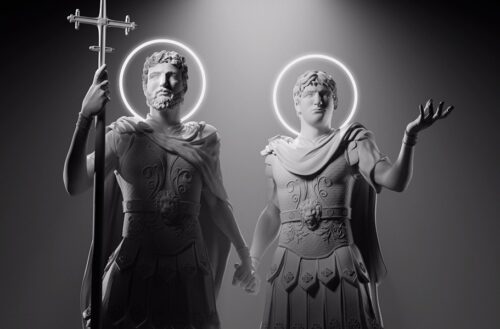
“Holy Love” is a digital sculpture of Sergius and Bacchus by William Niño Neuta
Early Christian saints Sergius and Bacchus appear as “patrons of homosexuality” on handsome handmade cufflinks from artist Shoushan of Artisan Courtyard. Sergius and Bacchus are available on shirts, cufflinks, pendants, lockets and bracelets through her My Altar shop.
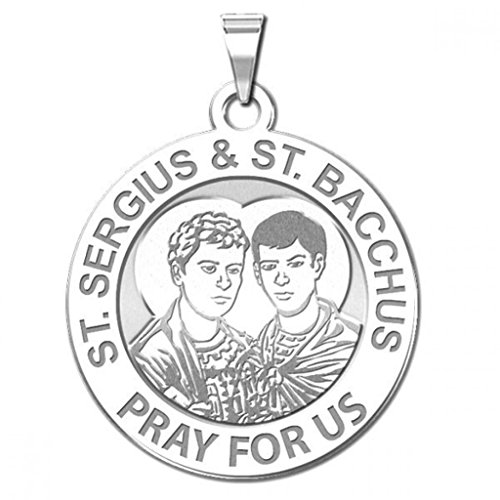 Sergius and Bacchus religious medals show the couple together with the words, “Pray for us.”
Sergius and Bacchus religious medals show the couple together with the words, “Pray for us.”
The relationship of Sergius and Bacchus was reimagined in dance by Elastic Theatre in 2009 and is available on video. The description states, “Some have come to believe that they were lovers, and their ambiguous relationship has raised fascinating and inevitably controversial issues of gender and sexuality in early Christianity. With an original vocal score devised collaboratively by the company and choreography by Lola Maury, the piece premiered at the Arcola Theatre in July 2009 and was subsequently presented as part of the Borderline Opera season at London Metropolitan University.”
Sergius and Bacchus prayers
Q Spirit’s Litany of Queer Saints includes these lines:
“Roman soldiers united in love and death, pray for us.”
A novena to Sergius and Bacchus is widely circulated on Roman Catholic websites to be prayed for nine successive days or weeks. It includes these lines:
“Our God showed how proud He was
of your love and courage,
when after the death of Bacchus,
when Sergius,
being at his lowest and loneliest,
began to lose heart,
and so the Lord sent
the spirit of Bacchus to Sergius
to allow him to console Sergius
with the promise that the two of you
would again be together in Heaven.”
How good, or how pleasant is the brotherly knowledge of Your Martyrs, O God.For they did not know natural brothers in the flesh,but for the faith were considered brothers who struggled until death.Through their prayers, O God, have mercy on us.
Two new hymns to Sergius and Bacchus was written by George Staelens, the blogger at “Blogue de Georges.” The hymns were performed at the Old-Catholic chapel of Saint Servais. Here is one stanza, which can be sung to many tunes such as “Old 100th.”
Stronger than death, the love has won ;
Sergius and Bacchus are but one ;
After their passion, they’re in heav’n ;
Together they shall rise again.
A set of historical hymns and prayers to Sergius and Bacchus are collected at andrejkoymasky.com. This part is especially striking:
“Crying out like David, O Sergius and Bacchus the Martyrs: Behold how good or how pleasant it is for Brothers to dwell together, for you were not bound by physical means, but in the manner of the faith. Therefore the Saints trampled upon the enemy, and taking up the cross, they followed Christ, and intercede to the King and God, that the great mercy may be granted to our souls.”
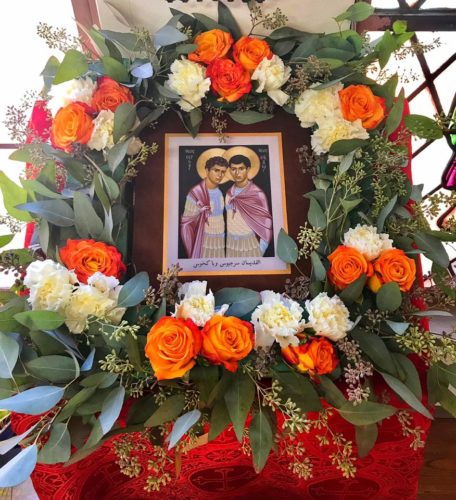
Icon of Saints Sergius and Bacchus displayed by Dignity San Fernando Valley,
Links related to Sergius and Bacchus
The Passion of SS. Serge and Bacchus (translated from original Greek by John Boswell)
Oratio ad Christum Iris (Rainbow Christ Prayer in Latin)
Santos Sergio y Baco: Una pareja masculina martirizada en la antigua Roma (Santos Queer)
La storia di Sergio e Bacco continua ad ispirare gli artisti contemporanei (Gionata.org)
___
Top image credits:
“Sergius and Bacchus” by Alessio Ciani
This post is part of the LGBTQ Saints series by Kittredge Cherry. Traditional and alternative saints, people in the Bible, LGBTQ martyrs, authors, theologians, religious leaders, artists, deities and other figures of special interest to lesbian, gay, bisexual and transgender and queer (LGBTQ) people and our allies are covered.
This article has evolved and expanded greatly since the first version was posted in October 2009. It was published on Q Spirit in October 2017, was enhanced with new material over time, and was most recently updated on Oct. 6, 2024.
Copyright © Kittredge Cherry. All rights reserved. Qspirit.net presents the Jesus in Love Blog on LGBTQ spirituality.
































While it’s beautiful that these two souls found each other as lovers which is to be of course celebrated, It is curious to me how they are saints if the rejected the nonviolent way of Jesus and served in and army of any sort let alone the imperial army of the Roman empire that was persecuting Christians at the time.
Wondering if there is more to the story. Wondering if they were defying orders to engage in violence.
Very few Christians in the first 300 years of the faith served in any army. It wasn’t until Constantine that violence became theologically justified.
Even Wikipedia – which is usually pretty liberal – admits that “historians have widely rejected this theory” (that Sergius and Bacchus were lovers), and even gay historians such as Alan Bray have rejected virtually all of John Boswell’s claims about these subjects. You’re also distorting the word “erastai”, which is defined in dictionaries as the older member of a pederastic relationship between a man and a boy, not between two men; so you’re unwittingly claiming that pedophilia was involved. I very much doubt that any ancient manuscripts described them using this word since it wouldn’t make any sense (they were both adult men, hence “erastai” could not possibly be applied to them). In any event, take a look at the following Wikipedia article for a summary of the consensus among historians, who have rejected Boswell’s claims about Sergius and Bacchus: https://en.wikipedia.org/wiki/Sergius_and_Bacchus
Well, Sts Sergius and Bacchus are the patrons of our oratory. Two years ago we celebrated by golden jubilee of ordination on the Sunday closest to Sts. Sergius and Bacchus. Our Bishop Monseigneur Joseph Paul Breton presided at the liturgy. and several old friends were in attendance. Wehad a smaller celebration the following year and this year I have admitted I need to have assistance in celebrating a Byzantine LIturgy. So I ordered two dozen roses for the patronal icon and we are celebrating with friends at a local Cajun restaurant. I felt personally blessed when I turned on you tube and Vespers of Sts. Sergius and Bacchus came right up in a lovely OCA celebration with a small but good choir. BTw we also celebrate St. Romanos the Melode on October 1 Frequently we combine the celebrations
Quisiera una lamina o postal de Sergio y Baco pars tenerla en el ricon religioso de mi apartamento. Me gusta mucho ls que ellos estan con uns bandera y vestidos con capas rojas y Sergio se ve con Barba.Qur puedo hacer para tener una asi que no cueste mucho ya que soy pobre?
Le sugiero que lo imprima desde una computadora.
Question: I would like a picture or postcard of Sergio and Baco to have it in the religious corner of my apartment. I really like that they are with a flag and dressed in red capes and Sergio is seen with a beard. What can I do to have one so that it does not cost much since I am poor?
Answer: I suggest that you print it out from a computer.
Just a wonderful collection of religious are for Sts Sergius and Bacchus. Dennis O’Neill was a few years behind me in school We are from the same Archdiocese originally and St. Martha is a prominent parish There is the coincidence of the feast of Sts. Sergius and Bacchus falling on the same day as the Feast of the Holy Rosary. Both feasts commemorate the victory of Lepanto (Naufractos. When their feast was suppressed from the Roman Calendar, their feast was observed with a series of three collects or commemorations. It is unlikely that Western Christians who pray the rosary would prefer these saints to the Rosary. By the same token their feast has a very rich proper in the Byzantine, especially Melkite and other Arab Churches
Kit, you are doing a marvelous job with your blog. Keep up the great work and thanks for this beautiful article on my favorite saints!
This is a beautiful ancient church in Istanbul which was dedicated to Sergius and Bacchus https://en.wikipedia.org/wiki/Little_Hagia_Sophia. Well worth a visit if you are in Istanbul.
Just a reminder that STs S and B are local saints. As such they are remembered on local calendars and they have a full office in the Melkite Church because they are the patrons of Syria and the Bedouins. A major icon for them was commissioned after the Battle of Lepanto that is called something else in the Christian East but the fact of the battle is part of the commemoration in the Christian East. They share their feast with saint Christina–so the wonderful icon is of our patrons with St. Christina. Growing up St. Christina Parish was a few miles south of us in the suburbs of Chicago. The Tridentines would still pray their collects because the reduction in collections had not occurred as extensively as Pope St. John XXIII edition of the 1962 Missale Romanum (which had already removed many non essentials)
Joe
Hi. Thank you for this beautiful article. I would like you to make a correction in the article. The Roman Catholic Church wasn’t “de-canonized” this two saints. But it’s true, that we don’t remember them at the holy mass, because that day we celebrate Our Lady of the Rosary. St. Sergius and Bacchus are entered in the Gneral Roman calendar (Martyrologium Romanum) of the Roman Catholic Church. Here is link to italian edition of the Roman Martirology https://www.liturgia.it/content/Martirologio-Romano.pdf (page 787). Thank you and God bless you and your work.
Dear Kitt et al
It’s Sergiobachumas! OUr patronal day rolls round again.
This year it is very special. It will be my golden sacerdotal jubilee. The honored his is His Grace Bishop (Vladyka) ) Paul Breton our local ECC Bishop travelling cross country to visit his lone parish in southland.
This will a musical and culinary gala. Please come if you are so inclined just let me know so I can make sure to have enough chairs. Food is never a problem. Being eastern AND gay ensures copious food.
We have a solo quartet to enhance the singing,. Y’all better participate and not let just the professionals sing.
This service will be festive but more in tune with the spirit of ECC. No commissioned Te Deum, no massed choir and orchestra (that was my 25th) We’re going to be more lavash than lavish this time.
(Fr) Joseph Cirou
Tadej, thank you for the clarification. I changed the word “de-canonized” to “downgraded.”
Joseph, congratulations on your 50 years of ministry and may everyone be blessed by celebration of Sergius and Bacchus!
Hi Kittredge,
Thank you for the fantastic information about Sergius and Bacchus. Their story very much inspired and is included in our new TV miniseries Shadowlands. In episode 3 a painter is commissioned by a church for an icon of Saint Bacchus and Sergius.
You can watch the show and share with your readers here: https://vimeo.com/ondemand/shadowlandstv
Our patronal icon of SS Sergiusband Bacchus were written by iconographers who donated our commission fee for Kosovo relief in the late 90’s
It seems the remains of these two saints had just been found:
http://talkradio.co.uk/news/remains-1700-year-old-gay-couple-found-iran-17101119613
Thank you for the wonderful article on our patrons Sts Sergius and Bacchus whose feast is today and whose liturgy we will celebrate tomorrow at 3:30PM
You may be interested in knowing that we commissioned our patronal icon about 15 years ago from artists who raising funds for Kosovo
I’m glad to know about your liturgy and icon commissioned from artists raising funds for Kosovo. Where can people see your icon online?